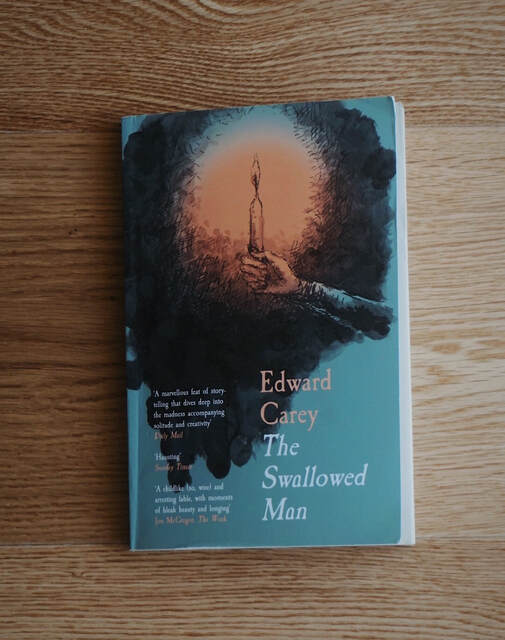The Swallowed Man
Author: Edward Carey
Published by: Gallic Books
Pages: 164
Format: Paperback
My Rating ★★★★
Published by: Gallic Books
Pages: 164
Format: Paperback
My Rating ★★★★
Trapped inside a giant sea beast with only the contents of the swallowed schooner Maria to sustain him, Geppetto yearns for the wooden boy he created out of greed but came to cherish as a son.
The ship provides materials for the carpenter to make art in the memory of Pinocchio and the other loves of his life. But the candles are running out, and the mind can only survive for so long without company.
The ship provides materials for the carpenter to make art in the memory of Pinocchio and the other loves of his life. But the candles are running out, and the mind can only survive for so long without company.
My thoughts:
**A big thank you to the author and Gallic books for sending me out a gifted copy of the book to read!**
The Swallowed Man is the author's retelling of the story of Pinocchio, the wooden boy created by the carpenter Geppetto who comes to life.
Carey tells the story from the perspective of the carpenter, Geppetto, known in the book as Joseph Lorenzini. At the start of The Swallowed Man, Joseph finds himself in the belly of a shark.
The shark’s vast interior gives Joseph space to explore the “black and black and ever more of black” until he finds a swallowed ship without survivors. There are preserved provisions — tins of meat, hardtack, tallow candles, waxed matches – which allow him to live a little longer. But perhaps his most significant find is the Captain’s log, which gives him the opportunity to write down his thoughts and experiences as he becomes “Emperor of Inner Sharkland.”
The captain’s log becomes many things, among them a biography, where readers learn of Joseph’s childhood in a family known for its pottery paintings. His failure as a painter eventually leads him to wood whittling, betraying the Lorenzini heritage, which declines after Joseph abandons his family’s craft.
The captain’s log also serves as a diary of Joseph’s time inside the “monster-beast” — from the daily debris that comes in when the shark opens its mouth to his fight against boredom and loneliness. He also writes of creating ceramic sculptures, dark portraits of past loves, and an attempt to make another wooden boy that goes awry. He records his most dark and reflective meditations on his life, exploring themes of fatherhood, redemption, loss and isolation.
There is so much creative spark in this beautiful book from Edward Carey, who entwines the power of art and imagination throughout this tale. Despite the strangeness and complexity of the narrative, Joseph’s story surprises and delights.
The Swallowed Man includes some of Carey’s own artwork, and the illustrations throughout the book further the feeling of strangeness. The visual work is grim yet oddly intriguing and I enjoyed how the author marries words and pictures in this tender story of fatherly pride and regret.
The Swallowed Man is ultimately a portrait of the artist contemplating his own existence. “There is no neat plot to a man’s life. There are endless days, which are as like as twins,” Joseph observes, and the author echoes this in his form — a novel that takes the shape of a constellation of memories recalled amid idle waiting.
With quirky and inventive writing, this is a wondrous little novel. The Swallowed Man is a darker take on Pinocchio, and whilst it won’t be for everyone, I found it entertaining.
Overall reaction:
**A big thank you to the author and Gallic books for sending me out a gifted copy of the book to read!**
The Swallowed Man is the author's retelling of the story of Pinocchio, the wooden boy created by the carpenter Geppetto who comes to life.
Carey tells the story from the perspective of the carpenter, Geppetto, known in the book as Joseph Lorenzini. At the start of The Swallowed Man, Joseph finds himself in the belly of a shark.
The shark’s vast interior gives Joseph space to explore the “black and black and ever more of black” until he finds a swallowed ship without survivors. There are preserved provisions — tins of meat, hardtack, tallow candles, waxed matches – which allow him to live a little longer. But perhaps his most significant find is the Captain’s log, which gives him the opportunity to write down his thoughts and experiences as he becomes “Emperor of Inner Sharkland.”
The captain’s log becomes many things, among them a biography, where readers learn of Joseph’s childhood in a family known for its pottery paintings. His failure as a painter eventually leads him to wood whittling, betraying the Lorenzini heritage, which declines after Joseph abandons his family’s craft.
The captain’s log also serves as a diary of Joseph’s time inside the “monster-beast” — from the daily debris that comes in when the shark opens its mouth to his fight against boredom and loneliness. He also writes of creating ceramic sculptures, dark portraits of past loves, and an attempt to make another wooden boy that goes awry. He records his most dark and reflective meditations on his life, exploring themes of fatherhood, redemption, loss and isolation.
There is so much creative spark in this beautiful book from Edward Carey, who entwines the power of art and imagination throughout this tale. Despite the strangeness and complexity of the narrative, Joseph’s story surprises and delights.
The Swallowed Man includes some of Carey’s own artwork, and the illustrations throughout the book further the feeling of strangeness. The visual work is grim yet oddly intriguing and I enjoyed how the author marries words and pictures in this tender story of fatherly pride and regret.
The Swallowed Man is ultimately a portrait of the artist contemplating his own existence. “There is no neat plot to a man’s life. There are endless days, which are as like as twins,” Joseph observes, and the author echoes this in his form — a novel that takes the shape of a constellation of memories recalled amid idle waiting.
With quirky and inventive writing, this is a wondrous little novel. The Swallowed Man is a darker take on Pinocchio, and whilst it won’t be for everyone, I found it entertaining.
Overall reaction:


